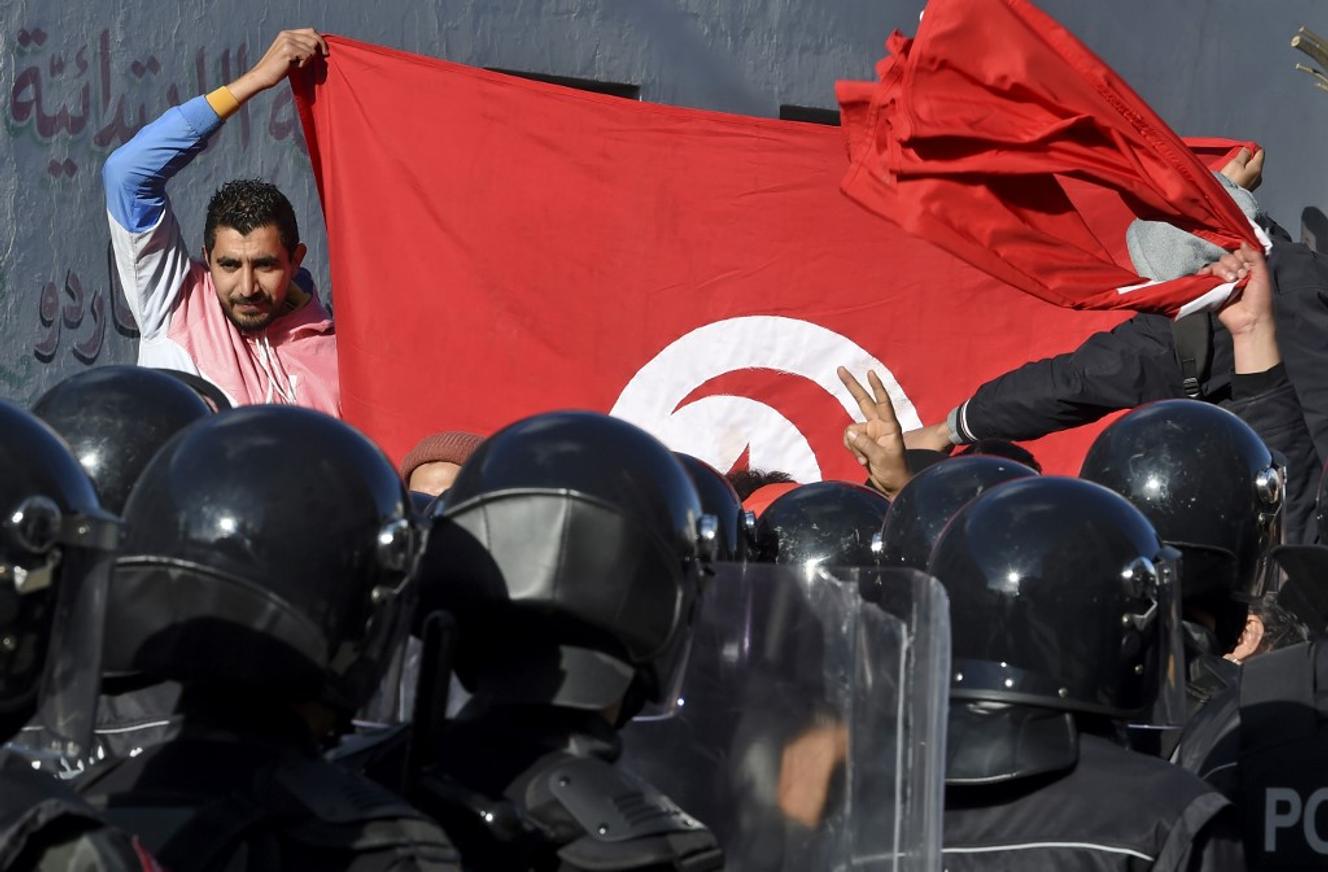“The revolution changed the relationship of youth to the State and to politics”
To stay up to date with African news, subscribe to the “Monde Afrique” newsletter from this link. Every Saturday at 6 am, find a week of current events and debates treated by the editorial staff of “Monde Afrique”.

Olfa Lamloum, political scientist, heads the Tunisian office of International Alert, an NGO with a strong presence in the regions of Tataouine (south, Libyan border), Kasserine (central west, Algerian border) and in the outlying districts of Tunis, Douar Hicher and City Ettadhamen. She has conducted several studies on the theme of marginality in working-class neighborhoods in cities and in the interior regions of Tunisia.
Since January 14, the anniversary of the fall of Zine El-Abidine Ben Ali, social mobilizations have taken place in many towns in Tunisia. Who are these demonstrators?
Olfa Lamloum The youth riots are part of a new cycle of protest. Already, in November 2020, the inhabitants of El-Kamour, near Tataouine (south), have, via a sit-in, blocked oil activities and forced the government to take measures for the unemployed, the precarious and obtain a better redistribution of wealth. In their wake, several governorates, hard hit by the economic crisis, have let their anger erupt. Then the protest subsided a bit before being revived on January 14. On that day, which marked the tenth anniversary of the revolution, a shepherd was attacked by a policeman in Siliana (center), one of the most marginalized towns in the country, because he had left his flock to graze in front of the governorate (prefecture). The scene of the assault was filmed and widely shared on social media. The same evening, demonstrations broke out in the city. This obviously recalls what happened in Sidi Bouzid in December 2010 when Mohamed Bouazizi, a young street vendor, set himself on fire after being humiliated by a municipal agent. It was this gesture that triggered the revolution.
The week before the Siliana incident on January 9, around 300 African Club supporters were arrested while demonstrating to denounce corruption in the management of the football club. This is a sports association from Tunis, but it has a national basis. So when there were the protests in Siliana, the club’s ultras, used to confronting the police, decided to join the protest.
Then, the protests passed the city of Siliana to reach the popular districts of the cities and the interior regions. The repression was very important: 1,600 people were arrested, including a third of minors. On January 19, 23 and 30, youth groups and civil society activists in turn organized demonstrations to denounce this repression.
This wave of mobilizations is therefore marked both by a greater participation of the 15-25 age group and a convergence between young people from the neighborhoods and those more organized in the capital.
Why are they mobilizing?
Ten years after the revolution, democratic gains have not translated into more economic and social rights. This new wave of protest puts them back on the agenda. She also denounces the questioning of the right to demonstrate with the blocking of avenues and places to prevent gatherings, but also the militarization of the police by its equipment and methods of maintaining order, as well as the provocations of certain unions. from police.
The demonstrators therefore come from various social and political backgrounds.…
Indeed, we observe for the first time a beginning of convergence between the groups of experienced militants, young people from working-class neighborhoods and groups of ultras. This is evidenced by the demonstration on January 23 in the working-class district of Tunis, Cité Ettadhamen, but also the presence, admittedly small but new, of young people from working-class districts at the demonstrations organized in the center of the capital, in particular in front of the Parliament. This is an important point, because it contributes to the political opening up of working-class neighborhoods.
Faced with this wave of protest, how did the authorities react?
They responded with repression [un jeune manifestant, Haykel Rachdi, est mort à Sbeïtla, dans le centre ouest]. On the side of the elites and the power, we also tried to depoliticize, discredit and even criminalize the movement by using the term vandalism. But the demonstrations that took place in Tunis and ended without clashes helped to discredit this speech.
Are these elites in denial, incomprehension or ignorance?
The ruling elites know that the economic and social crisis is serious and that it has worsened further with the pandemic. Figures from the National Institute of Statistics clearly show that ten years after the revolution, the poverty map remains the same: it is the three governorates of the interior – Kasserine, Kairouan and Sidi Bouzid – which are the most affected. Our organization works in the field in Tataouine (in the south, on the Libyan border), Kasserine (in the center west, on the Algerian border) and in the outlying districts of Tunis, Douar Hicher and Cité Ettadhamen. It is estimated that in these places more than two-thirds of 18-34 year olds do not have social security coverage. In Douar Hicher and Cité Ettadhamen, often presented as major providers of “Foreign fighters” gone to Syria and Libya, the budgets allocated to social services are paltry. In Douar Hicher, for example, which had 82,000 inhabitants in 2014, the youth center only has 470 euros per year, once its charges have been paid. to cover the activities of its facilitators.
The ruling elites know these figures, but they have not broken with the strategic, economic, political and social choices of Ben Ali’s time. Security governance is the main mode of regulation and supervision of young people on the “fringes”, perceived as a threat to public order. To ensure social peace, we reuse old recipes: creation of fictitious jobs in semi-public companies, distribution of some social assistance to the most deprived, but also tolerance towards the informal economy and subsistence activities.
In any case, the dispute seems to fall back in the regions…
Repression has a very significant deterrent effect. But the underlying reasons for the mobilization remain. These are the same ones that led to the wave of protest against Ben Ali. Unemployment, poverty, dropping out of school, lack of social security… This reality is not changing. The same causes lead to the same effects.
In the field, what do these young people tell you?
As part of our latest study, “Young people on the margins”, published in November 2020, we asked this question: “How can we improve the situation of young people? “. In Kasserine, for example, more than a third of those questioned answered “A new revolution” and more than half said they had participated in a protest before. We are facing a generation which experienced the revolution and became sociable in this unprecedented event which changed its relationship to the State and to politics.
In these neighborhoods, democratic gains are far from being obvious. These young people do not vote, even if they were more numerous to do so during the presidential election of 2019. The central form of their political participation is protest, and the response provided by the authorities is often security.
For these young people, organized forms of political action are not an option?
There is a significant generational stall. The youngest no longer believe in political parties as being able to be relays to change their lives. The same goes for the powerful trade union center, the Tunisian General Labor Union (UGTT): it is the consequence of the crumbling of the wage system among the new generations confronted with austerity policies.
What role do security and judicial institutions play with regard to this youth?
Our last movie, Feel what is happening released in January 2021, begins with the story of Akrout, a 28-year-old from Douar Hicher, who says: “I can’t count the number of times I’ve been arrested by the police. “ Jailed for two weeks in 2008 during a demonstration against the Israeli attacks in Gaza, he was then arrested several times at the stadium or in the street. A ten-month prison sentence for cannabis use knocked him out of college for good. Akrout is the typical example of a young person from a working-class neighborhood shattered by institutional violence.
The problem with the font isn’t all about individual smudges. It is that of a security apparatus for a long time in the service of an authoritarian regime backed by an orderly justice. There have been no reforms of these institutions, other than a superficial grooming. Even today, instead of investing in the social, we are strengthening security governance.
The reform of institutions, their accountability, their control from below is a fundamental question. However, it depends on the establishment of a genuine participatory democracy involving citizens, in particular those of relegated territories, and not only of “Consultations” carried out at the request of donors.





